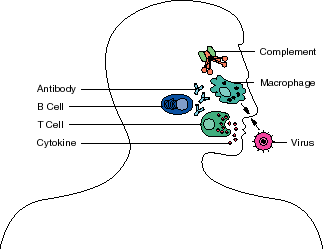|
How Does the
Immune System Work?The immune
system defends the body from attack by invaders recognized
as foreign. It is an extraordinarily complex system that
relies on an elaborate and dynamic communications network
that exists among the many different kinds of immune system
cells that patrol the body. At the heart of the system is
the ability to recognize and respond to substances called
antigens whether they are infectious agents or part of
the body (self antigens).
Cells and molecules of the immune system protect the nose from attack by a virus.  . . 
T cell (lymphocyte) with a T-cell receptor on its surface T and B Cells Most immune system cells are white blood cells, of which there are many types. Lymphocytes are one type of white blood cell, and two major classes of lymphocytes are T cells and B cells. T cells are critical immune system cells that help to destroy infected cells and coordinate the overall immune response. The T cell has a molecule on its surface called the T-cell receptor. This receptor interacts with molecules called MHC (major histocompatibility complex). MHC molecules are on the surfaces of most other cells of the body and help T cells recognize antigen fragments. B cells are best known for making antibodies. An antibody binds to an antigen and marks the antigen for destruction by other immune system cells. Other types of white blood cells include macrophages and neutrophils. Macrophages and Neutrophils Macrophages and neutrophils circulate in the blood and survey the body for foreign substances. When they find foreign antigens, such as bacteria, they engulf and destroy them. Macrophages and neutrophils destroy foreign antigens by making toxic molecules such as reactive oxygen intermediate molecules. If production of these toxic molecules continues unchecked, not only are the foreign antigens destroyed, but tissues surrounding the macrophages and neutrophils are also destroyed. For example, in individuals with the autoimmune disease called Wegener's granulomatosis, overactive  A macrophage engulfing a bacterium and releasing packets of toxic molecules (reactive oxygen intermediates) that break down and destroy the bacterium. A macrophage engulfing a bacterium and releasing packets of toxic molecules (reactive oxygen intermediates) that break down and destroy the bacterium. Please continue to page three of autoimmune inflammation pathway  Click to view different size nerve fibers. Click to view different size nerve fibers.
|